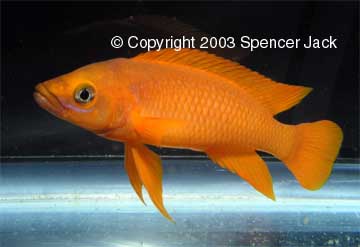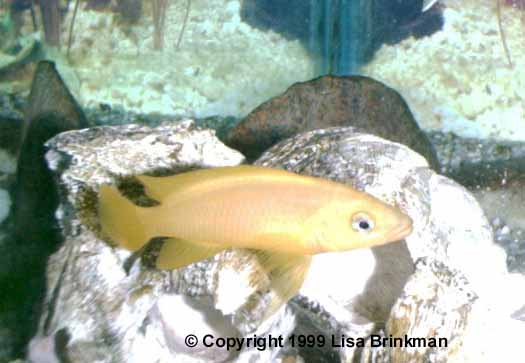
|

|

|

|
Synonyms: Lamprologus leleupi, Lamprologus leleupi longoir, L. leleupi leleupi, L. leleupi melas
Meaning of Name: leleup - was named after a biologist and member of the I.R.S.A.C. (Institute Reserche Scientific Afrique Centrale)
Common Name: Lemon Cichlid
Family: Cichlidae:
Type Location: Northwestern shore of Lake Tanganyika near Luhanga, Zaire
Distribution: Northwestern part of the lake and Mtoto, Zaire.
This fish was originally described in 1956 by Poll. But it was not introduced to the hobby until 1958.
It is found 5 metres or deeper in between large round rocks. The highest concentrations are found at approximately 15-20 metres deep.
This fish requires a pH of around 7.5-8.5 and a temperature of 25-30C.
This fish has no clear sexual dimorphism other than size. Some males may develop a cranial bump. His pelvic fins may be longer. They grow to approximately 4" long. They are a long bodied yellow fish. There are populations that are darker coloured. The bright yellow leleupis just lack the black pigment that hides the yellow colouration underneath.
In the wild these fish are predatory, feeding on aquatic insects and crustaceans. They are monogamous cavespawners. They lay over 100 eggs on the upper part of a cave. Fry hatch within 2 ½ - 3 days. They become freeswimming in 5-6 days.
I originally had these fish approximately 3 years ago. At that time I had 5 of them along with a trio of Aulonocara nyassae 'Eureka orange'. They had grown to about 3" in length and were showing what I had read was pre-spawning behaviour. Then disaster struck. All the leleupi within 24 hours of each other all just sat on the bottom of the tank not moving. They all died within a day of showing the sickness. They did not show any signs of being ill other than sitting on the bottom of the tank. When I removed the bodies, all their fins appeared to melt off in the net. I had never seen this before (and so far have never seen it again). I had then gotten into some other cichlids so the leleupi were put on the back burner again. Last year I bought 4 leleupi fry at an auction. I grew them up. When they were reaching about 3½ inches, I had still seen no sign of them spawning or any activity leading me to believe that they ever would. So when I had visited Wet Thumb I bought 5 more in the hopes of giving me a confirmed female. They were only about 2½" long. They were all placed in a 90 gallon tank. This tank was kept at 78F. The pH runs from 7.8-8. It is decorated with rocks, slate, and shells on top of a gravel substrate. The filters are Aquaclears. There is no light on top of this tank as the room is fairly bright considering all the natural light that comes into my fishroom.
Even after getting all these fish and waiting for them to grow up, it seemed like nothing was ever going to happen with them. I was getting very frustrated by this. One day one of the largest leleupis took over a cavity in a barnacle shell. I thought nothing of it since a lot of the leleupi had shells of their own in the tank. I was doing a water change in the tank one day and happened to notice something in the shell. It was newly hatched fry. They were still stuck to the shell. I then freed up a 20 gallon tank filtered by a sponge filter for the fry. I 'stole' a few fry to raise up. I did loose a few. I think it was because it really was too soon to move them. The fry were fed baby brine shrimp and liquid fry food. They are growing nicely now. I have noticed that one of the fry is a lot darker then the others but I figure that is because it has taken over living on top of a really dark filter and is trying to blend in as best as it can.
© Copyright
1999, 2000, 2001 Lisa Brinkman
All Rights Reserved
Suggested Viewing:
Lake Tanganyika:Jewel of the Rift (National Geographic1997)
Suggested Reading:
Pierre Brichard's Book of Cichlids and All the Other Fishes of Lake Tanganyika by Pierre Brichard
Tanganyika Cichlids in their natural habitat by Ad Konings
Guide to Tanganyika Cichlids (Back to Nature) by Ad Konings
Lake Tanganyikan Cichlids: Everything About Purchasing, Care, Nutrition, Behaviour, and Aquarium Maintenance (Barron's Complete Pet Owner's Manuals) by Mark Smith
The Cichlid Aquarium by Dr. Paul Loiselle
Baensch Aquarium Atlas by Dr. Rüdiger Riehl & Hans A. Baensch
Success with Cichlids from Lake Malawi & Tanganyika by Sabine Melke, U. Erich Friese
Fishkeepers Guide to African Cichlids by Paul Loiselle
To see more references on cichlids: